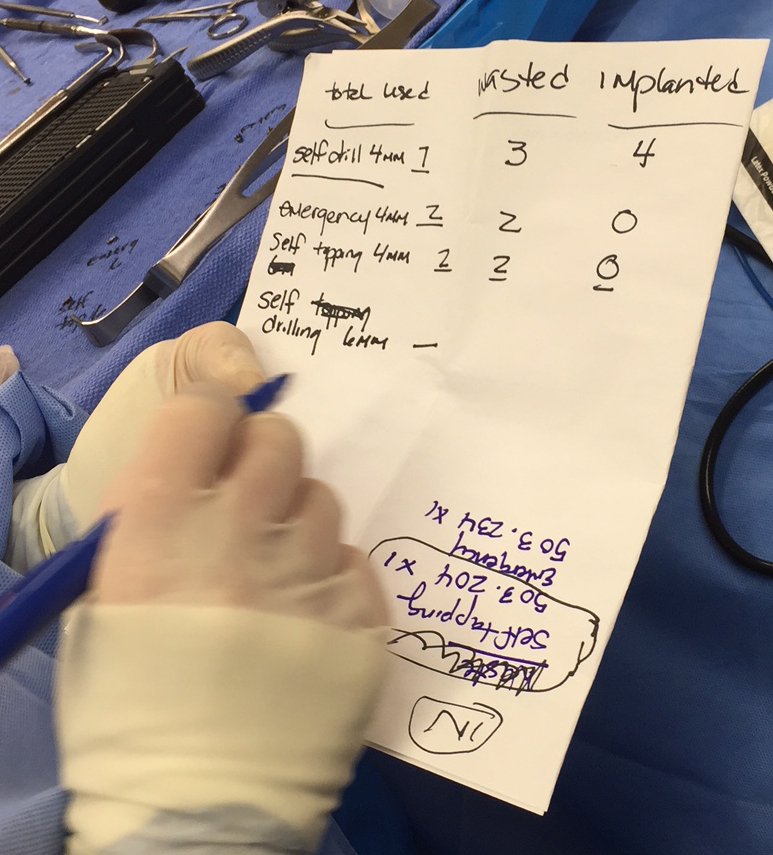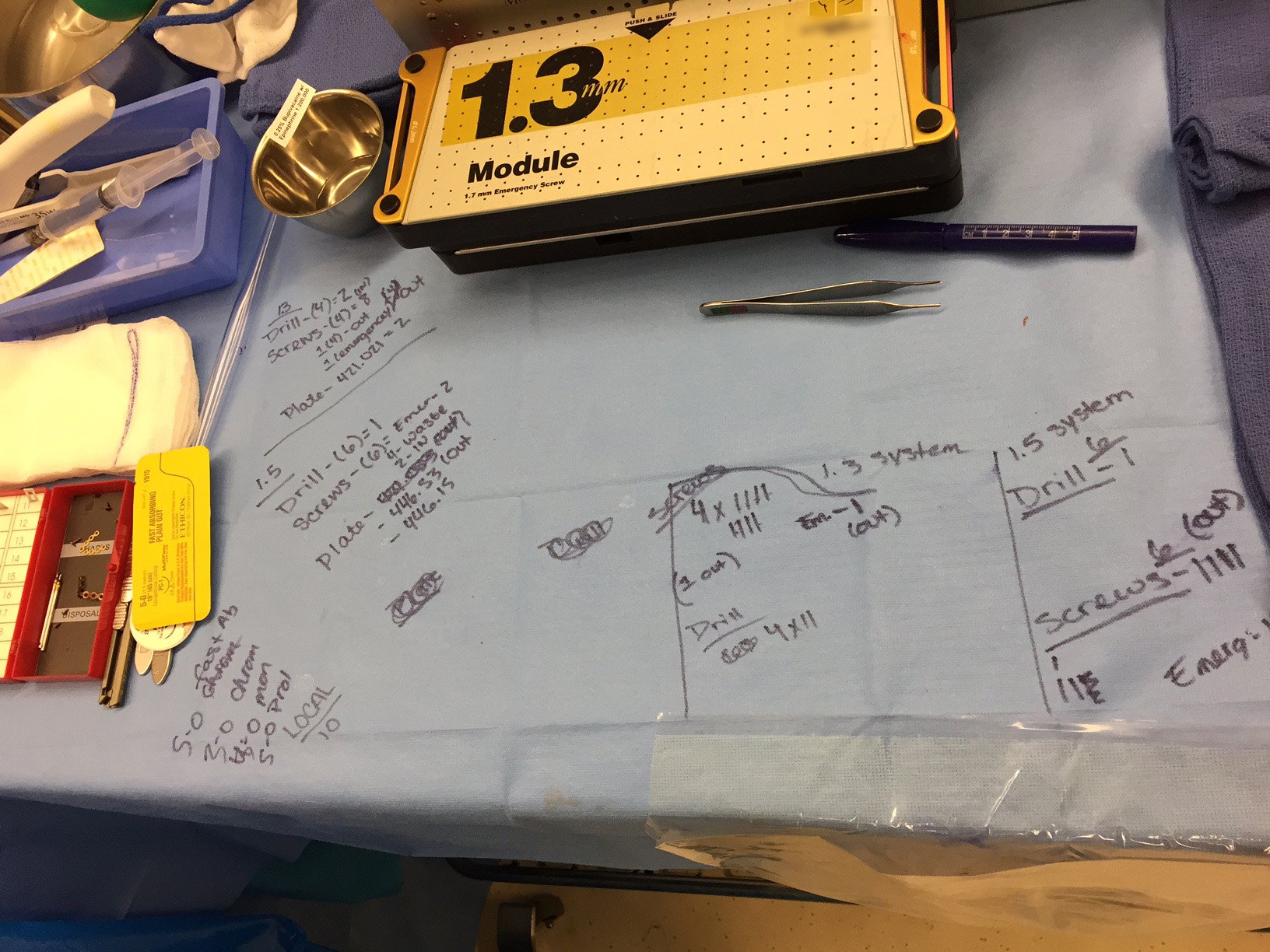The Summate Workflow: The Key to Implant Supply Chain Automation and Reduced Labor Costs for Ortho Surgery
How the Summate Workflow Increases Accuracy and Dramatically Reduces OR Labor Costs for Ortho Surgery
With the Summate Workflow, the surgical technician controls ALL implant dispositions from the sterile field
I have written extensively about how Summate brings a new scanning technology to enable scanning orthopedic implant usage directly from the sterile field. The concept of Set Mapping will open a data avalanche for device OEMs, giving them real time windows into usage data which will be incredibly valuable for both marketing and inventory control. While solving device industry problems through point-of-use (POU) scanning is predicated on making the sets and trays “smart”, it would all be for naught without a complimentary piece of workflow technology that Summate has developed.
Orthopedic implants used directly from sets and trays have a complex usage flow, leading to several possible ultimate dispositions for these implants. Usually, the surgeon picks the correct implant, but sometimes it is deemed “not suitable’ for a variety of reasons and is rejected, or “wasted” in medical terms. This means it is set aside in favor of another implant. The following are the four different usage paths/dispositions of implants that need to be accurately tracked during surgery.
1. Add to Patient. The simplest implant usage path. The implant is picked and put into the patient, where it stays.
2. Return to Tray. The implant is selected, brought to the patient site, and before it is bent, or inserted into the bone, is rejected. This implant, since it has not been altered or put into the bone, can be put back in the tray for future surgeries (or use later in this surgery)
3. Wasted. The implant is selected, and bent or in the case of a screw, inserted into the bone. It is subsequently rejected (usually after looking at a radiograph) and needs to be explanted and another more suitable implant is selected and used. Another usage case is if a screw doesn’t get correct ‘purchase” into softer bone and a larger diameter screw (“rescue screw”) is needed. These implants are taken out, but not put back in the tray because they cannot be used in a subsequent surgery. They are considered “wasted”.
4. Re-implanted: The final tracking path for an implant is “re-implanted”. In this case a wasted implant which was deemed not optimal is re-implanted back into the current patient. An example of this is a screw which might have been not long enough, is in fact long enough due to a different subsequent insertion location on the bony anatomy. It can move from “wasted” to “re-implanted” in this situation.
Tracking all these usage paths and dispositions during surgery is tricky and can be confusing and messy, as evidenced by these two pictures from actual surgeries of how surgical technicians recorded implant usage inside the sterile field:
It’s a mess. Not optimal.
And yet we are not even close to being done.
Now that the info has been scribbled out inside the field on the back table drape or a scrap piece of paper (usually without part numbers), all this information needs to get into the patient record running on the computer outside the field across the OR. The next steps for recording these implants is a multi-step process involving 2 or 3 people: the surgical technician who hands off the implants and manually writes them down (pictured above), the device rep who interprets the written descriptions and assigns part numbers, quantities and dispositions, and a circulating nurse who takes all this information from the device rep and manually enters it into the patient record. If there is no rep present, the circulating nurse must do the interpretation and then do the manual entry. The numbers are long and complex, to complicate matters. In summary, it often takes 3 (high salaried) people to record implants used in an orthopedic surgical case!
The whole process is error prone, time consuming, and often incomplete. Studies show that over 50% of surgeries involving these implants have incorrect patient records, and it’s easy to see why. And this messy process in the OR leads to even messier problems in the supply chain - that is another story for another day. Suffice it to say that it leads to huge inventory management problems for both the healthcare provider and the device companies as well. The problem is compounded by the fact that these implants are expensive, with single screws costing upwards of 100-200 dollars, and plates sometimes running over 1000 dollars.
How Summate Solves the Problem…
Summate’s in-field POU scanning technology straightens out almost all the complexity in this process through eliminating all the interpretation and enabling the surgical technician to accurately record and control all implant dispositions from the sterile field, and all within their current workflows, with no extra time required - at the true point of use.
Summate’s patented workflow control enables the surgical technician to control implant disposition, all in a faster workflow that is 100% accurate.
The Summate software runs in “add to patient” (green on the screen) mode. As implants are selected and put into the patient, their usage is scanned and records on the ScanTrakker screen in a running tally. If an implant is selected and subsequently needs to be returned to the tray, the technician scans the “return” tag (turning the screen red) and then the implant’s tag, returning it to the tray inventory and removing it from the “in patient” column. For wasted, the tech scans the “wasted” tag and then the implant’s tag. Lastly, the same process for implants that are wasted and then re-used: a scan of ‘re-imp” and the implant tag. An accurate, running tally is kept. Quite clever! (and patented, I might add). After each of these alternate implant dispositions are recorded, the software defaults back to the green “add to patient” mode for smooth continued scanning implants added to the patient
Of course, since all the data is digitized through scanning, there is no need to have a device rep transcribe the scribbles, and for the circulating nurse to enter them into the computer. As a note, through our partnership with Symmetric Healthcare Solutions the ScanTrakker also offers totally unique label imaging technology for recording items used from packages, recording not only the product ID information but also all the critical production data (serial number, expiration date) in one simple imaging step, thereby eliminating all the manual data entry for those products.
Summate’s implant scanning workflow relies on one person only - the surgical technician - instead of the current three (surg tech, sales rep, circulating nurse). It is simple to execute and 100% accurate. 100% accuracy at point of consumption will lead to implant re-supply automation, incredible new data for device companies, and a quantum leap in operational and supply chain efficiency. Overall, it will dramatically lower implant costs for end users who adopt ScanReady sets and trays and adopt the Summate Workflow for tracking implants.
The ScanMan screen, run on our cloud software, presents all surgical usage info to field personnel
60% of a hospital’s product spend goes through the Operating Room. With the proven and undeniable cost savings offered by POU scanning, the Summate ScanTrakker offers healthcare providers a potentially transformational technology for their financial health. For medical device OEMs, Summate offers never accessible granular real-time data that will allow them to better manage their field assets and cashflows.
It’s time for the Operating Room and the OEM device industry to Put Scan in The Plan, with Summate Technologies.





